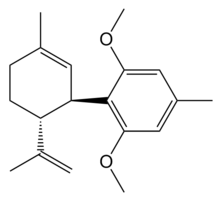O-1918
 | |
| Identifiers | |
|---|---|
| |
| CAS Number | |
| PubChem CID | |
| Chemical and physical data | |
| Formula | C19H26O2 |
| Molar mass | 286.19 |
| 3D model (JSmol) | |
| |
O-1918 is a synthetic compound related to cannabidiol, which is an antagonist at two former orphan receptors GPR18 and GPR55, that appear to be related to the cannabinoid receptors. O-1918 is used in the study of these receptors, which have been found to be targets for a number of endogenous and synthetic cannabinoid compounds, and are thought to be responsible for most of the non-CB1, non-CB2 mediated effects that have become evident in the course of cannabinoid research.[1][2][3][4][5]
See also
References
- ↑ Offertáler, L.; Mo, F. M.; Bátkai, S.; Liu, J.; Begg, M.; Razdan, R. K.; Martin, B. R.; Bukoski, R. D.; Kunos, G. (2003). "Selective ligands and cellular effectors of a G protein-coupled endothelial cannabinoid receptor". Molecular Pharmacology. 63 (3): 699–705. PMID 12606780. doi:10.1124/mol.63.3.699.
- ↑ Zakrzeska, A.; Schlicker, E.; Baranowska, M.; Kozłowska, H.; Kwolek, G.; Malinowska, B. (2010). "A cannabinoid receptor, sensitive to O-1918, is involved in the delayed hypotension induced by anandamide in anaesthetized rats". British Journal of Pharmacology. 160 (3): 574–584. PMC 2931558
 . PMID 20105178. doi:10.1111/j.1476-5381.2009.00579.x.
. PMID 20105178. doi:10.1111/j.1476-5381.2009.00579.x. - ↑ Schuelert, N.; McDougall, J. J. (2011). "The abnormal cannabidiol analogue O-1602 reduces nociception in a rat model of acute arthritis via the putative cannabinoid receptor GPR55". Neuroscience Letters. 500 (1): 72–76. PMID 21683763. doi:10.1016/j.neulet.2011.06.004.
- ↑ Szczesniak, A. M.; Maor, Y.; Robertson, H.; Hung, O.; Kelly, M. E. M. (2011). "Nonpsychotropic Cannabinoids, Abnormal Cannabidiol and Canabigerol-Dimethyl Heptyl, Act at Novel Cannabinoid Receptors to Reduce Intraocular Pressure". Journal of Ocular Pharmacology and Therapeutics. 27 (5): 427–435. PMID 21770780. doi:10.1089/jop.2011.0041.
- ↑ Caldwell, M. D.; Hu, S. S. J.; Viswanathan, S.; Bradshaw, H.; Kelly, M. E.; Straiker, A. (2013). "A GPR18-based signaling system regulates IOP in murine eye". British Journal of Pharmacology. 169 (4): 834–43. PMC 3687663
 . PMID 23461720. doi:10.1111/bph.12136.
. PMID 23461720. doi:10.1111/bph.12136.
This article is issued from
Wikipedia.
The text is licensed under Creative Commons - Attribution - Sharealike.
Additional terms may apply for the media files.